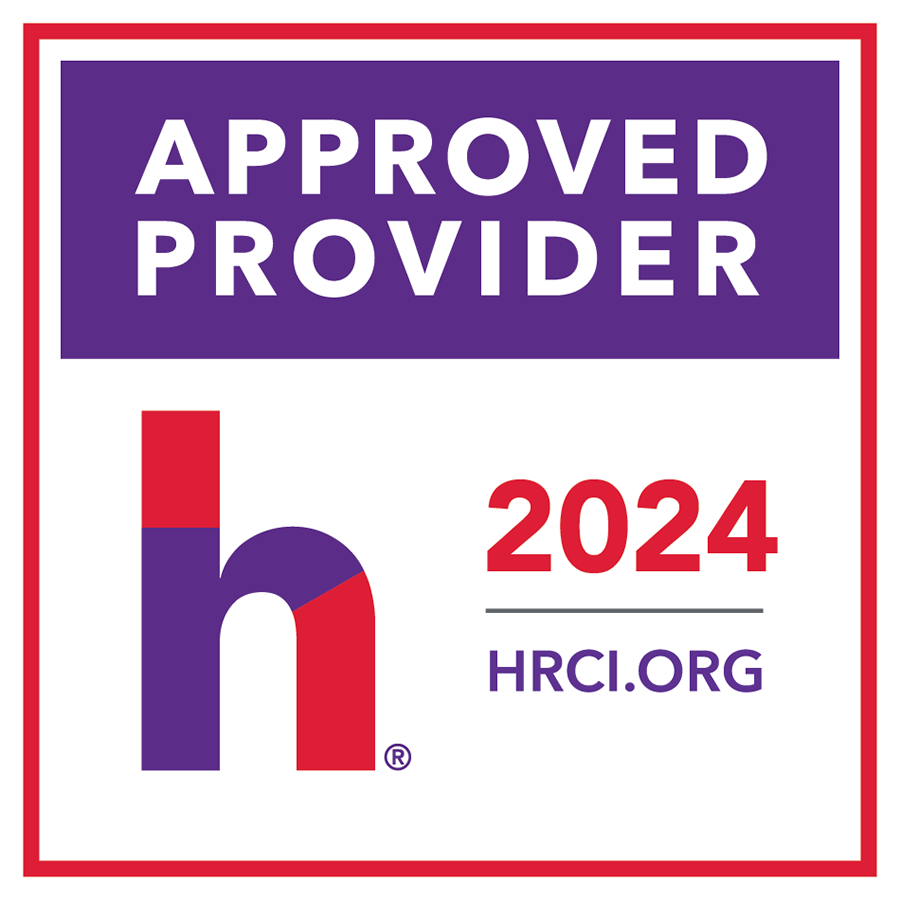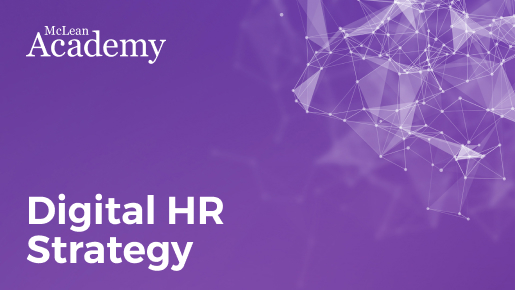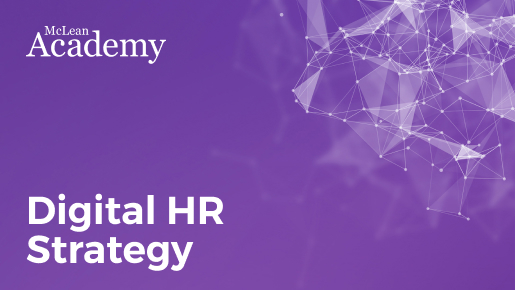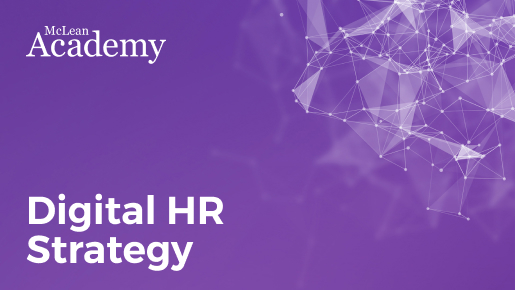- Seventy-seven percent of organizations do not have a documented HR technology strategy (McLean & Company, HR Trends Survey, 2021; n=431), resulting in existing technology solutions that were selected reactively and fail to effectively meet client needs.
- Many HR departments are not taking any action to support digital transformation and are left out of key decisions around HR technology selection and implementation, despite being the primary users and facilitating its adoption throughout the organization.
Need Extra Help?
Speak With An Analyst.
- Get on-demand project support
- Get advice, coaching, and insight at key project milestones
- Go through a Guided Implementation to help you get through your project

Our Advice
Critical Insight
Creating a digital HR strategy without considering the client experience risks not meeting the needs of a modern workforce. To be successful, HR’s digital strategy must balance the organization’s needs with the needs of the people who will be actively interacting with the processes and systems.
Impact and Result
- Develop a holistic digital HR strategy that is owned and driven by HR in collaboration with other key stakeholders to realize benefits such as greater HR efficiency and improved client experience and engagement.
- Focus on the client experience to ensure the people who will be actively interacting with the processes and systems have direct input into the strategy to maximize buy-in, adoption, and impact.
- Ensure strict prioritization and take a phased approach to maintain a manageable workload. The goal is to create a multi-year, living strategy, not to achieve a static end-state.
- Incorporate change management into the roadmap and communications of the digital HR strategy to create reasonable timelines, encourage adoption, and maximize the benefits realized.

Digital HR Strategy

This program has been approved for continuing professional development (CPD) hours under Section A of the Continuing Professional Development (CPD) Log of the Human Resource Professionals Association (HRPA).

McLean & Company is recognized by SHRM and can award Professional Development Credits (PDCs) for the SHRM-CP® or SHRM-SCP®.

HR Certification Institute's® (HRCI®) official seal confirms that McLean & Company meets the criteria for pre-approved recertification credit(s) for any of HRCI’s eight credentials, including SPHR® and PHR®.
How to complete this course:
Use these videos, along with the Project Blueprint deck above, to gain an understanding of the subject. Start with the Introduction, then move through each of the Course Modules. At the end of each Module, you will be required to complete a short test to demonstrate your understanding. You will complete this course when you have completed all of the course tests.
- Number of Course Modules: 5
- Estimated Completion Time: 1.5 hours
Learning Outcome
Develop a holistic digital HR strategy that is owned and driven by HR in collaboration with other key stakeholders to realize benefits such as greater HR efficiency and improved client experience and engagement.
Learning Objectives
By the end of this course, learners will be able to:
- Recognize the role HR plays in developing a digital HR strategy.
- Identify priority HR technology elements.
- Investigate the client digital experience.
- Determine and categorize digital opportunities.
- Describe the factors involved in creating a digital HR strategy roadmap
Course Modules

Introduction

Module 1

Module 2

Module 3

Module 4
Workshop: Develop a Holistic Digital HR Strategy
Workshops offer an easy way to accelerate your project. If you are unable to do the project yourself, and a Guided Implementation isn't enough, we offer low-cost delivery of our project workshops. We take you through every phase of your project and ensure that you have a roadmap in place to complete your project successfully.
Module 1: Define Digital HR Current State
The Purpose
Define the digital HR current state within the organization.
Key Benefits Achieved
A thorough review and definition of the current state of HR’s digital environment
Activities
Outputs
Review organizational and HR goals to align with digital HR strategy.
- Digital HR scope
Review client questionnaire results and insights.
- Digital HR purpose statement
Take an inventory of current HR processes and systems.
- High-level HR process maps
Map the current state of HR technology systems.
- HR technology systems map
Prioritize HR technology elements.
Module 2: Elicit Pain Points and Digital HR Needs
The Purpose
Elicit pain points and digital HR needs from core HR technology elements and workforce management technology elements.
Key Benefits Achieved
Identified pain points and digital needs for both core HR and workforce management
Activities
Outputs
Elicit and capture pain points and digital needs from core HR technology elements.
- Core HR pain points and digital needs
Elicit and capture pain points and digital needs from workforce management technology elements.
- Workforce management pain points and digital needs
Module 3: Elicit Pain Points and Digital HR Needs (continued)
The Purpose
Elicit pain points and digital needs from talent management technology elements and strategic HR technology elements.
Key Benefits Achieved
Identified pain points and digital needs for both talent management and strategic HR.
Activities
Outputs
Elicit and capture pain points and digital needs from talent management technology elements.
- Talent management pain points and digital needs
Elicit and capture pain points and digital needs from strategic HR technology elements.
- Strategic HR pain points and digital needs
Module 4: Identify Digital Opportunities and Initiatives
The Purpose
Identify and prioritize digital opportunities and initiatives.
Key Benefits Achieved
- List of digital opportunities from each technology element
- List of prioritized initiatives to address digital opportunities
Activities
Outputs
Identify and categorize digital opportunities stemming from pain points and needs in each technology element.
- Digital opportunities from each technology element
Brainstorm digital HR initiatives to address opportunities.
Prioritize digital HR initiatives.
- Prioritized list of initiatives to address digital opportunities
Module 5: Create a Digital HR Strategy Roadmap
The Purpose
Create a digital HR strategy roadmap to implement changes.
Key Benefits Achieved
A digital HR strategy roadmap that includes a high-level change management plan and a high-level communications plan
Activities
Outputs
Plan communications with impacted stakeholders and the organization.
- Digital HR strategy roadmap
Create a high-level change management plan.
- High-level change management plan
Plan communications with impacted stakeholders and the organization.
- High-level communications plan
 Develop a Holistic Digital HR Strategy
Develop a Holistic Digital HR Strategy
 Select a Human Resources Information System
Select a Human Resources Information System
 Preparing for an Internal Talent Marketplace
Preparing for an Internal Talent Marketplace
 Develop a Learning Technology Strategy
Develop a Learning Technology Strategy
 Get the Best Value Possible With a Data-Driven Vendor Negotiation Approach
Get the Best Value Possible With a Data-Driven Vendor Negotiation Approach
 Harness the Potential of Generative AI in HR
Harness the Potential of Generative AI in HR
 AI Preparation Guide for HR
AI Preparation Guide for HR
 Develop Responsible AI Guiding Principles
Develop Responsible AI Guiding Principles